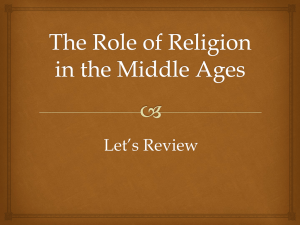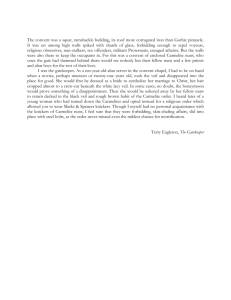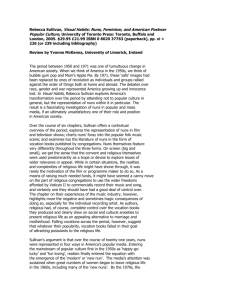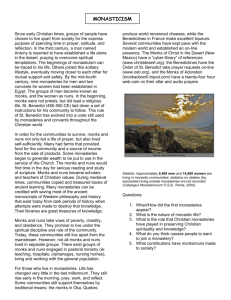Read article - Dickinson Blogs
advertisement
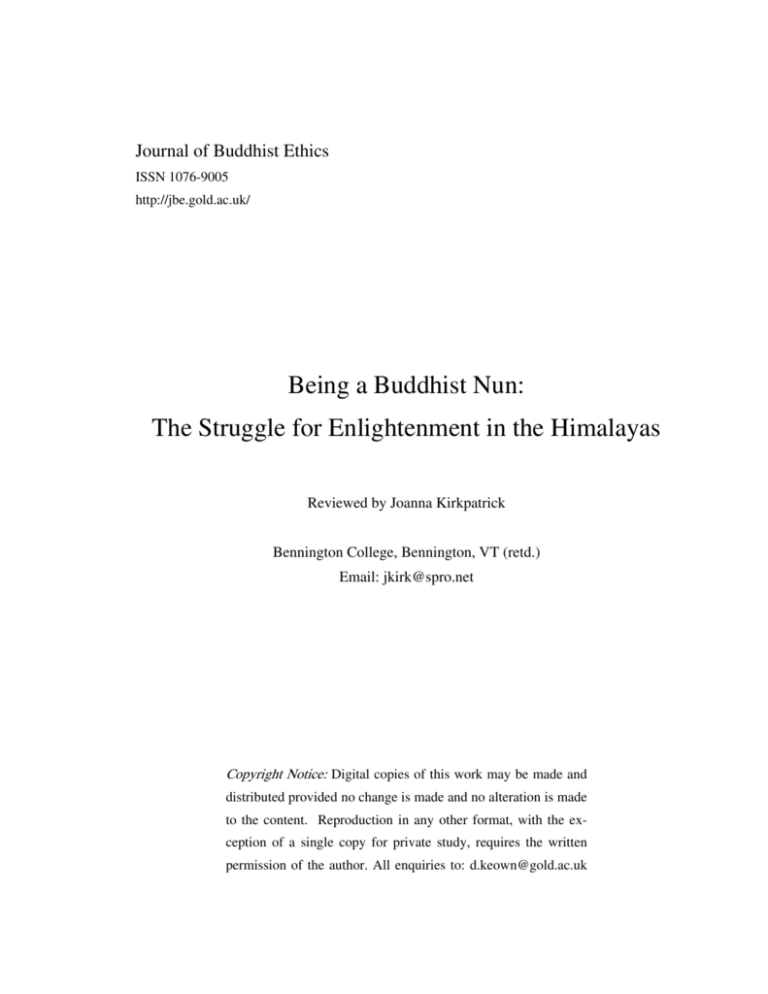
Journal of Buddhist Ethics ISSN 1076-9005 http://jbe.gold.ac.uk/ Being a Buddhist Nun: The Struggle for Enlightenment in the Himalayas Reviewed by Joanna Kirkpatrick Bennington College, Bennington, VT (retd.) Email: jkirk@spro.net Copyright Notice: Digital copies of this work may be made and distributed provided no change is made and no alteration is made to the content. Reproduction in any other format, with the exception of a single copy for private study, requires the written permission of the author. All enquiries to: d.keown@gold.ac.uk Review of Being a Buddhist Nun: The Struggle for Enlightenment in the Himalayas Joanna Kirkpatrick* Being a Buddhist Nun: The Struggle for Enlightenment in the Himalayas. By Kim Gutschow. Cambridge, MA: Harvard University Press, 2004. 333 pages. Cloth. ISBN 0674-01287-9. Dr. Gutschow’s book—a revision of her 1998 doctoral dissertation from the Department of Anthropology at Harvard—is a study of Buddhist nuns in a Tibetan tradition, mostly living in Zangskar, Ladakh, India. The contents consist of eight chapters: gendering monasticism, locating Buddhism in Zangksar, the Buddhist economy of merit, the Buddhist traffic in women, becoming a nun, why nuns cannot be monks, can nuns gain enlightenment?, and monasticism and modernity, plus notes, references, and an index. Gutschow spent many years off and on living in Ladakh while she pursued her field study by participating in the lives of nuns and conducting interviews and other research among the various villages associated with * Bennington College, Bennington, VT (retd.) E-mail: jkirk@spro.net Kirkpatrick, Review of Being a Buddhist Nun 114 the monasteries of the area. This study is a comprehensive report on and analysis of the manifold psychological, economic, political, and spiritual aspects of life for nuns, as well as monks, in a human cultural and economic context that always includes the various families and clans of origin of both monastic genders who, unlike monastics in some other cultures and traditions, are not for the most part living far away from their natal kin. Local merit-making imperatives persist in kin requesting monks for rituals, while nuns—generally prohibited from performing public rituals— must assist their families in agricultural work, as these practices guarantee their material support. Monks do not work the fields. Their material support by kin is guaranteed by monks’ access to merit-making rituals and the merit families also automatically gain by sending a son into the monastic life. Nuns are deprived by local monastic understandings from making merit via public rituals, and while families stand to gain merit by allowing a daughter to take monastic vows, they also resist this option, preferring to marry off daughters and gain affinal connections thereby. Women are needed for field labor in a subsistence economy where field labor tends to be in short supply, so nuns are often called on by kin to supply such labor. Thus, while they often find a lama who will give them instruction in some tantric rituals that they then practice within their nunneries for the purpose of gaining enlightenment, they express great frustration about the agricultural and nunnery subsistence roles expected of them such that they have little time for religious practice and meditation. The local culture of nuns as Buddhist renouncers takes a dim view of women’s capacity for enlightenment because of intrinsic impurities. As Gutschow writes: Journal of Buddhist Ethics 115 Buddhist merit-making practices suggest that women are triply handicapped. Their lesser store of merit from past lives explains not only why they suffer in this life but also why they have fewer opportunities to improve their prospects for the next life. Ritual practices surrounding childbirth and fertility of house and field specify the female body as inferior or impure. …The bottom line is clear. No Buddhist in her right mind desires a female body. …Many of my informants in Zangskar repeated this idea [derived in their views from Tsongkhapa’s teachings on karma] when they expressed the wish to be reborn as a male. Villagers make merit by donating to monks in the hope of being reborn as males or monks at the top of the social hierarchy. Most lay people seem uninterested in deconstructing a system of patronage from which they hope to benefit one day. (17) Gutschow employs an economic model to explain the merit system: “…merit and capital are concentrated at the top of a hierarchy which is at once social and moral.” Merit is also relative to the existing merit of both donors and recipients. “As such monks, who have the most merit, are also the most worthy recipients of gifts… Ironically, those monks seen as the most virtuous—like the Dalai Lama—acquire the largest streams of wealth. They are given palaces which they will never inhabit, even as nearby nuns struggle to subsist.” (17) One is reminded here of the advertisements one finds in various contemporary Buddhist magazines that appeal for donations to Tibetan Buddhist nuns and nunneries. One does not see the same for male establishments, most of which are heavily subsidized by devotees. So the acquisition and distribution of material capital is coterminous with the same process for moral resources. The maintenance of poverty of female beings, and the retention of wealth according to fa- Kirkpatrick, Review of Being a Buddhist Nun 116 milial status, is supported by and also dependent on this Buddhist merit system. Gutschow notes that while lay people do occasionally donate to the poor, such acts do not displace the central position of donating to high monks and monasteries. While some people will quote adages to the effect that a donation of the self and its attachments alone is worthy of great merit, “…yet numerous practices index social or economic capital to the symbolic capital of merit… While the rich and monks can earn merit by donating or performing elaborate ritual spectacles, the nuns, laywomen, and the poor lack the ritual skills or wealth to earn merit in such prestigious ways.” (18) While monks might be fined or expelled from the monastery for sexual misbehavior, the monasteries lose no prestige as a result. Lay people grumble in private, but the system remains publicly intact. Gutschow relates many individual nun’s stories to accompany her exacting account of the politics and economics of both genders’ monastic lives in Ladakh. She spent some months in one nunnery to live with the nuns and learn from them directly about the vicissitudes of their material and religious lives. The poverty of these nuns was extreme, by contemporary standards, and they did practically all of their own labor in supplying and maintaining their nunnery. Going out for days to collect dung from the hills for cooking and heating fuel was one of the onerous tasks that they were forced by the cultural gender model to do for themselves. Nunneries do not have the funds to hire labor. She quotes a contemporary feminist Ladakhi nun, Tsering Palmo, from an aristocratic family with connections to high Buddhist educational institutions, about her first visit to Ladakhi nunneries: “I was shocked… I didn’t realize how bad it was. Some nuns didn’t have enough to eat or decent clothes to wear. Many had never had a single Dharma teaching…” (236) Because of their ascribed impurity and inferiority, the nuns rarely were given teachings and religious instruction. Lacking time for solo prac- 117 Journal of Buddhist Ethics tice was also a main frustration of the nuns in Zankgskar. Yet ironically, thanks to the rise of feminist-oriented initiatives in Ladakh and Leh, nunneries are expanding. The Sakyadhita Conference of 1995 held in the town of Leh, which nuns from all over the world attended, brought about a surge of support for building nunneries and making other contributions to the life of Buddhist nuns in Ladakh. Earlier, in 1990, synergy between local Buddhism and foreign feminism appeared when the Women’s Alliance of Ladakh was formed with the help of the resident Swedish expatriate, Helena Norberg-Hodge. This group helped to organize the Sakyadhita Conference, and also “the largest ever gathering of nuns to perform a Tara Puja in Leh’s holiest temple, the Jokhang, in 2001.” (243) After these surges in reform, attempts to create professional training institutes for nuns in some cases were thwarted by abbots; sometimes villagers refused to sell land for financial investment by a nunnery—apparently because “local elders… balked at... nuns acquiring either landed wealth or power in the local community….” (245) Foreign nuns, such as Karma Lekshe Tsomo, helped to raise funds for Zangskar nunneries as early as the mid1980s. Gaining the approval of the Dalai Lama facilitated her works of nunnery support in the area, as it has also done for various other works of construction and nun education in Ladakh. (See Chapter 8 for a detailed account of foreign intervention and monastic modernization in the lives of Ladakhi nuns.) Feminist nuns like Tsering Palmo have been trying to arrange practical training for nuns in connection with institutions such as hospitals, clinics and schools, so that they can earn to support their nunneries, but Ladakhi politicians and their high monastic connections react ambivalently. Conflict and competition also afflict foreign donor organizations. As Gutschow observes: “Petty competition between different sets of do-gooders undermines overall development efforts. Every group follows its own leadership, often resisting collaboration and a single hierar- Kirkpatrick, Review of Being a Buddhist Nun 118 chy of power…. As a result, local nuns and even foreign feminists continue to bow and scrape before the local Rimpoches in hopes of a blessing or favor… [and] monastic hegemony remains largely undisturbed.” (251) Gutchow concludes with the observation that, in these times of rapid global change, “For nuns as well as monks, upholding the Buddha’s moral discipline is critical to the continuity of the monastic order. Yet nuns can only hope to perpetuate their discipline if they are granted the material endowments, ritual patronage, and respect historically reserved for monks.” (256) Reading between and with the lines of her analysis of the political-economy of monasticism in Ladakh, at least, despite some recent changes and improvements, I am not hopeful of long-term, stable outcomes for its women monastics. This study of Buddhist nuns is especially valuable for its in-depth coverage of not only Buddhist values, practices, and persons, but for the author’s analysis of the intricate politico-socio-cultural contexts that link all players in Zangskar as well as in Ladakh. It is not a fast read, but it comes highly recommended to students of Tibetan Buddhist monasticism.

